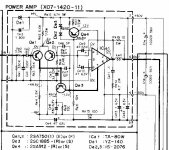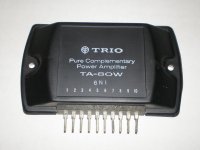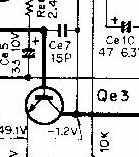Hello again dear friends.Some days ago I took the KENWOOD KA-7300 from the technician and I gave it a hearing test and <<shot>>.I was expecting at least a sound similar to my AKAI AM-2350 but more powerfull more detailed and both vocals and instruments to be accurate and generally pleasant to listen.Apart from that I listened to a sound tiring with no sound image not detailed and only powerfull.I don't know if the amplifier plays naturally like **** or I have to replace some other parts in order to listen something close to my ΑΚΑΙ.The technician replaced the electrolytic capacitors and some of the diodes.Can I do something to change the sound quality dramatically?What are the most important parts that make the difference to the sound quality?Thank you and I am looking forward for your suggestions.Nikos
Hello
Here's the complete schematic of you amp.
Download kenwood ka-7300 sch-1.jpg
I include the power amp section schematic, the amp section use a TA-80W power Ic, so you can't change the output section of the power amp section.
At 15 pF the capacitors are a quite low value for Ce7 in the schematic (in the 3rd image), you can replace it by a 47 pF capacitor on both channels. It seem that this low value of Ce7 may be part of the cause of the sound to be a bit agressive and tiring.
Bye
Gaetan
Here's the complete schematic of you amp.
Download kenwood ka-7300 sch-1.jpg
I include the power amp section schematic, the amp section use a TA-80W power Ic, so you can't change the output section of the power amp section.
At 15 pF the capacitors are a quite low value for Ce7 in the schematic (in the 3rd image), you can replace it by a 47 pF capacitor on both channels. It seem that this low value of Ce7 may be part of the cause of the sound to be a bit agressive and tiring.
Bye
Gaetan
Attachments
Last edited:
Indeed there's not alot that can be changed in the power amp itself, but, there is also all the tone controls etc. in front of it that affects the sound as well. Since it has direct input jacks to the power amp try running a source into it to bypass the tone section and see if the its the amp or the input section that makes it sound the way it does. This will help narrow down where to spend your efforts. Of course changing any electrolytic capacitor in the signal path should help as well.
Parts in the preamp are best left alone; typically the preamp is the least hard-working part of your gear, so there's not much that can go bad over time, unlike the electrolytics and such from the power section and supply.
I found the best way to get good sound from mine was to listen with all controls "flat", no boosting or crossover settings, etc. and make small adjustments from there to correct for room imbalances. Otherwise, I fall into a habit of flipping the switches hoping for magic to come out (I have been guilty of abusing tone controls on much of the gear I have owned) and I have to force myself to simply listen to how the music was originally recorded and make incremental adjustments for the room.
Also, it could be your Akai already produces a sound space that works well with your room, and you have grown accustomed to how that sounds. I can say the Kenwood is very versatile with it's tone shaping (in fact I find it rather daunting sometimes) but with a little work I believe you can settle it in.
The capacitor fix Gaetan8888 suggests may help; what it would do is lower the bass roll-off point into the power amp section. Doing that may reduce some resonance in the lower registers from the low-pass filters stacking up, especially if you tend to keep the bass reined in somewhat. Give it a try, and also make it a point to listen to different sources (tape, vinyl, receiver) just to give your ears more material to focus on what you might be able to change in the tone control..
If not, I believe it's a nice enough piece of gear that you can get a good price for it but hopefully it won't come to that.
-Eddy
I found the best way to get good sound from mine was to listen with all controls "flat", no boosting or crossover settings, etc. and make small adjustments from there to correct for room imbalances. Otherwise, I fall into a habit of flipping the switches hoping for magic to come out (I have been guilty of abusing tone controls on much of the gear I have owned) and I have to force myself to simply listen to how the music was originally recorded and make incremental adjustments for the room.
Also, it could be your Akai already produces a sound space that works well with your room, and you have grown accustomed to how that sounds. I can say the Kenwood is very versatile with it's tone shaping (in fact I find it rather daunting sometimes) but with a little work I believe you can settle it in.
The capacitor fix Gaetan8888 suggests may help; what it would do is lower the bass roll-off point into the power amp section. Doing that may reduce some resonance in the lower registers from the low-pass filters stacking up, especially if you tend to keep the bass reined in somewhat. Give it a try, and also make it a point to listen to different sources (tape, vinyl, receiver) just to give your ears more material to focus on what you might be able to change in the tone control..
If not, I believe it's a nice enough piece of gear that you can get a good price for it but hopefully it won't come to that.
-Eddy
Thank you all of you for your answers.Today after a thorough listening test I noticed some problems that could affect the overall sound quality.First of all I connected the kenwood as a power amplifier,giving signal from a Nakamichi AV-10 as a pre-amp,I was surprised because I had an improvement in most of the sound levels.Then I played independently only the kenwood.The problem I noticed was that when I swithced to both A+B speakers the sound was thin without the bass strength and in place A or B was ok.The second was that I had some noise from time to time between the tracks and also some times inside the track.And the third was that with the balance selector down on right channel I had very high noise level not heard in switch selector on neutral position.I know that all of these maybe are strange, but I believe that there are still switches or knobs that affect to the bad sound quality that's why when I connect this kenwood as a power amp I have no problem with the sound.Indeed I had the tendency to listen with the filters on,in flat position the sound was better.Any ideas would be appreciated.Thank you.
I understand from your complaint that you are hoping for audiophile quality sound from an average quality, 80's hybrid amplifier. I think you might expect better than what you describe but not greatly better. In 30 years, sound quality in discrete AB class amplifiers has moved on, leaving the many problems in those older, budget designs behind.
FWIW, changing Miller compensation caps (Ce7), doesn't have much to do with bass reproduction - that's the role of the feedback electrolytic, Ce5, which does seem a bit small in any case. The compensation of an amplifier is not something that can be independently tweaked to any significant degree without affecting stability margins, gain and bandwidth that require adjustments elsewhere. I don't think it will be disastrous to increase the value but I would start with a lower figure like 27-33pF. Check the type of cap already fitted - this is critical to compensation caps and it should never be a low cost ceramic cap unless it is of the NPO type (often indicated by a black painted top). Usually, audiophiles like to replace these with more expensive old parts like silvered mica and polystyrene caps but polypropylene fim caps are also fine. 'Careful with PS types - they melt with prolonged soldering time.
Finally, if you are hearing intermittent noise from the preamplifier, there are problems unsolved there. It is a complex, 3 band active filter using simplest possible transistor stages. It even looks noisy and something to bypass completely, but it also needs attention such as the replacement of all electrolytic caps. Service technicians are loath to do this without your acceptance because the cost of this is high, may not always bring about noticeable differences and shocks owners of old amps that have never been fully serviced in 30-40 years. Don't expect this to be done without negotiations.
FWIW, changing Miller compensation caps (Ce7), doesn't have much to do with bass reproduction - that's the role of the feedback electrolytic, Ce5, which does seem a bit small in any case. The compensation of an amplifier is not something that can be independently tweaked to any significant degree without affecting stability margins, gain and bandwidth that require adjustments elsewhere. I don't think it will be disastrous to increase the value but I would start with a lower figure like 27-33pF. Check the type of cap already fitted - this is critical to compensation caps and it should never be a low cost ceramic cap unless it is of the NPO type (often indicated by a black painted top). Usually, audiophiles like to replace these with more expensive old parts like silvered mica and polystyrene caps but polypropylene fim caps are also fine. 'Careful with PS types - they melt with prolonged soldering time.
Finally, if you are hearing intermittent noise from the preamplifier, there are problems unsolved there. It is a complex, 3 band active filter using simplest possible transistor stages. It even looks noisy and something to bypass completely, but it also needs attention such as the replacement of all electrolytic caps. Service technicians are loath to do this without your acceptance because the cost of this is high, may not always bring about noticeable differences and shocks owners of old amps that have never been fully serviced in 30-40 years. Don't expect this to be done without negotiations.
Hello.I have this amp recapped and replaced also the majority of the electrolutic caps by a technician.Now about the specific problem that I had the chance to figure out.The overall sound is thin without strength especially in a+b speakers tremedous low performance comparing with <<A>> or <<B>> independently,and after 20-30min of reproduction the right channel fails,has some sound triggering and harse noise.This is audible with the channel selector in neutral position as well as when you put the selector in the right channel position.I suppose from what I have read inside the forum that there are some problems with the ka-80w trio,and also with the oxidation.The problem is that I have to order the deoxit from a site abroad and I am not sure if I will have improvement.When I told the technician if he has checked the ka-80 he told me that if there was a problem the protection cirquit would have been activated.Also he has done an inside cleaning with his own tools(he told me about a combination of deoxit stuffs).Thank you.any ideas?


So you have a problem when using 2 sets of speakers at the same time. If you play it loud that way, you will likely be activating the protection which will cause it to sound bad anyway. "Thin sound" suggests there is no bass and most likely will involve caps. I would ensure that all electrolytic caps in the amplifier, particularly Ce5, had been replaced with correct types, not just general purpose ones and not just a few of them.
I think that if you have had this repaired by a technician it is up to him to explain why his repairs lead to an unsatisfactory product. We can only guess at what has or has not been done properly so it is difficult to make suggestions, not knowing what really has changed. If the amplifier actually sounded better before the repair, I think you must take it up with the tech first.
Do you have any knowledge of electronics and the equipment and ability to do repairs yourself?
I think that if you have had this repaired by a technician it is up to him to explain why his repairs lead to an unsatisfactory product. We can only guess at what has or has not been done properly so it is difficult to make suggestions, not knowing what really has changed. If the amplifier actually sounded better before the repair, I think you must take it up with the tech first.
Do you have any knowledge of electronics and the equipment and ability to do repairs yourself?
- Status
- This old topic is closed. If you want to reopen this topic, contact a moderator using the "Report Post" button.
- Home
- Amplifiers
- Solid State
- KENWOOD KA-7300 NOT SATISFIED


